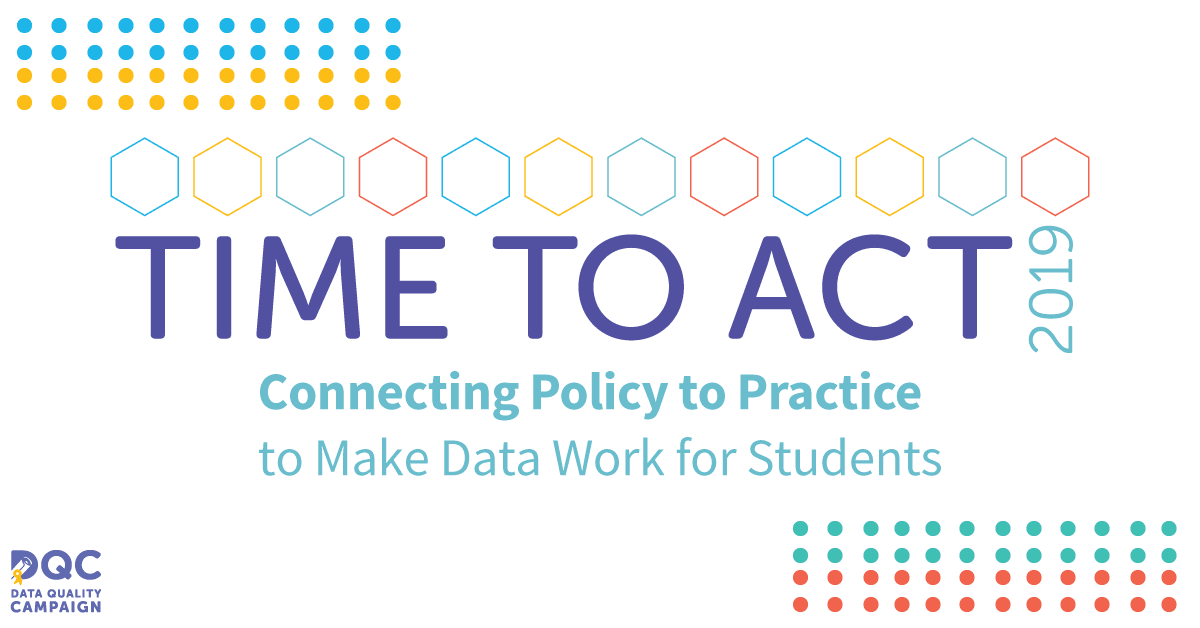States are connecting policy to practice to make data work for students. The most effective state efforts to improve student outcomes don’t exist in a silo; they cut across multiple policy priorities to make data work for students. And while their crosscutting data initiatives can still be strengthened, some states are supporting schools with efforts that reach across the Data Quality Campaign’s (DQC) Four Policy Priorities to Make Data Work for Students. As state leaders seek to use data to improve school quality and support student success, they must push past solutions that address only one policy priority and tackle changes that solve multiple policy implementation challenges.
Our policy priorities provide an important framework to organize action that supports student achievement. To ensure that people have the information they need to answer questions and take action, states must:
- Measure What Matters. Be clear about what students must achieve and have the data to ensure that all students are on track to succeed.
- Make Data Use Possible. Provide teachers and leaders the flexibility, training, and support they need to answer their questions and take action.
- Be Transparent and Earn Trust. Ensure that every community understands how its schools and students are doing, why data is valuable, and how it is protected and used.
- Guarantee Access and Protect Privacy. Provide teachers and parents timely information on their students and make sure it is kept safe.
Stakeholders value education data. Results from DQC’s 2019 parent and teacher polls show that both groups value and use data to help support students. More than 90 percent of parents say that they support teachers using data to ensure that students are getting the support and enrichment they need, and 86 percent of teachers agree that using data is an important part of being effective in their jobs. With these attitudes about data in mind, states should prioritize supporting families, educators, school leaders, and community members with the high-quality data they need to help students excel.
States cannot meet their goals for student success in the K-12 classroom and beyond without data. These state examples demonstrate some of the ways state leaders can work across big policy priorities to make data work for students. More exemplars like these are needed. State policymakers—including state education agency leaders, state boards, legislators, and executive leadership—must prioritize investments in data access and use now.
Below we share examples of how states are connecting policy to practice to make data work for students. Read the full report for more.
[policypriority name=”Measure What Matters”]Measure What Matters[/policypriority]
Texas measures what matters by ensuring that those closest to students have the right information to help all students succeed. The Texas Education Agency (TEA) sheds light on the performance of educators across the state by collecting a variety of information about its teacher workforce. These measures include, but are not limited to, the following information about individual educator preparation programs (EPPs):
- program acceptance rate
- number and percentage of admitted teacher candidates who graduate fully certified
- number and percentage of program graduates who remain in the profession for five years
- the five districts in which the largest number of program graduates teach
Measuring indicators that span a teacher candidate’s preparation experience, from EPP to the classroom, helps leaders answer a variety of questions about their teacher pipeline and ultimately supports more nuanced and informed policymaking.
[policypriority name=”Make Data Use Possible”]Make Data Use Possible[/policypriority]
Idaho makes data use possible by giving educators and school leaders the training and support they need to take action with data. Idaho makes certain that local schools are supported by aligning the data in its report card with the needs of local leaders. Traditionally, local leaders would collect and share data with the state education agency and then engage at the local level in continuous improvement planning. Now the report card provides data that local leaders need so they can reflect on their schools’ performance and jump straight into continuous improvement planning. By equipping local leaders with the data they need and eliminating an unnecessary reporting step, state leaders have decreased the burden on local leaders and allowed for more targeted decisionmaking.
[policypriority name=”Be Transparent & Earn Trust”]Be Transparent & Earn Trust[/policypriority]
Idaho is transparent and earns trust by making sure all stakeholders understand how their schools are performing and how data is being used to help students. Idaho seeks to reach all communities by publishing a range of data about school quality, above and beyond what is federally required, in an easy-to-find and easy-to-navigate report card. The report card is translated into languages other than English and features performance data for newly required student groups, including military-connected students, students in foster care, and students experiencing homelessness.
[policypriority name=”Guarantee Access & Protect Privacy”]Guarantee Access & Protect Privacy[/policypriority]
Tennessee guarantees access and protects privacy by ensuring that educators have access to data based on their role. Tennessee prioritizes appropriate access to data for school leaders involved in strategic planning. Through InformTN, approved users access the system with a single sign-on and are supported by the state with any access issues. Additionally, Tennessee provides guidance on which leaders are best suited to use the data in InformTN for planning to better ensure that student needs are met while data is being kept safe.


